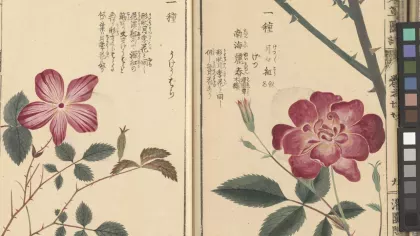15 March 2018
Launching the Science Collections Strategy 2018–2028
The strategy’s editors describe how this important document will guide the development of Kew’s globally important Science Collections over the next ten years.

Kew’s vast scientific collections of plants and fungi from across the globe lie at the heart of the organisation. They provide the foundation for describing and understanding the world’s plant and fungal diversity, helping to find solutions to some of the greatest challenges faced by humanity. Now, for the first time in Kew’s history there is a formal strategy setting out a framework for managing, developing and providing greater access to the Science Collections over the next decade.
The Science Collections are a global resource for plant and fungal knowledge and comprise:
- the Herbarium – 7 million pressed plant specimens
- the Spirit Collection – 76,000 specimens preserved in spirit
- the Fungarium – 1.25 million specimens of dried fungi & over 1,000 fungal cultures in liquid nitrogen
- the Economic Botany Collection – 100,000 samples documenting the use of plants by humans
- the Seed Collection at the Millennium Seed Bank – 86,000 collections and over 2 billion seeds
- the DNA and Tissue Bank – 48,000 samples of plant genomic DNA & 10,000 tissue samples
- the Microscope Slide Collection – 150,000 microscope slides of plant and fungal anatomy
- the In Vitro Collection – 6,000 living plant and fungi cultures in jars of agar
What is the strategy and what will be achieved?
Kew’s Science Collections Strategy is a document that sets out a framework for the development of Kew’s Science Collections over the next decade. It asks four key questions:
- What collections do we currently have?
- What current and future collections are critical to our research priorities;
- How do we manage and develop our collections?
- How do we increase access to our collections?
Some of our key objectives
To better understand the collections, we aim to complete an audit of all our Science Collections – to include an understanding of age, quality of specimens and geographical scope.
To support our research priorities, critical gaps in the collections will be filled in line with Kew’s scientific vision and research priorities. We will focus collecting activities on vascular plants and fungi that:
- Increase representation from target areas in Sub-Saharan Africa, Central and South America, South-East Asia and the UK Overseas Territories, and additionally the UK for fungi, native seed and selected threatened species. We will focus particularly on endemic, threatened, and ecologically or economically important species.
- Help to fill key gaps in our knowledge of the Plant and Fungal Trees of Life.
- Allow the study of the patterns and drivers of diversification in our target plant and fungal families.
- Underpin trait-based research, to enable greater understanding of the drivers of plant and fungal characteristics and their evolutionary and ecological relevance.
- Increase our understanding of resilience to global change and to plant pests and disease.
- Are important to food security – primarily selected crops and their wild relatives but also including edible wild plants.
- Are associated with pollinators that play key roles in ecosystem function, crop pollination and bee health.
- Contribute to human health and well-being.
- Ameliorate the effects of global climate change.
To manage and develop our collections, we will:
- Adopt standards such as Museum Accreditation for preserved collections and Global Genome Biodiversity Network standards for the DNA and Tissue Bank.
- Develop a new ‘Kew Cryosphere’ storage facility at the Millennium Seed Bank at Wakehurst, providing greatly extended cryogenic storage and training facilities and the ability to bank key desiccation-intolerant tropical and temperate tree species.
- Improve infrastructure for the collection, curation and storage of genomic and transcriptomic data.
- Establish protocols for environmental sampling, to support research into fungal diversity.
- Employ a multi-collection sampling approach, where feasible, so that each plant, fungus or population contributes complementary material to two or more of our collections.
To increase access to our collections, we will:
- Digitise Kew’s 8.5 million science collections, including images of all herbarium specimens, fungarium type specimens and fungarium specimen labels.
- Through the Millennium Seed Bank Partnership, provide a global resource for wild seed collection data and supply.
- Make all data and images accessible through our online portals – Plants of the World Online and Fungi of the World Online – where permitted by law, international policy and partnership agreements.
- Build a digitally accessible UK ‘Open Herbarium’ (established with UK partners) providing access to images of herbarium specimens held in major UK herbaria.
- Develop collections displays and opportunities to interact with specimens as an integral part of the Kew Science Festival and other public engagement events in the gardens.
- Enhance crowdsourcing initiatives to increase data capture, analysis and citizen scientist engagement with all collections.
Why is the strategy important?
Kew’s Science Collections cover an estimated 95% of vascular plant genera and 60% of fungal genera and are fundamental to describing and understanding plant and fungal life on Earth. These collections underpin research that can help find solutions to some of the greatest challenges faced by humanity – climate change, food security and disease. This strategy aims to ensure the great value of the Science Collections are preserved and enhanced for the future of plant and fungal science.




